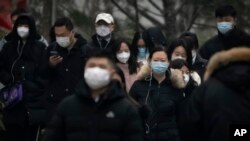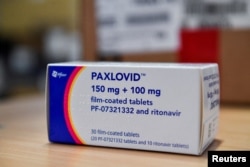As China grapples with a massive surge of coronavirus infections, a new study by a Chinese university estimates the virus has infected some 900 million people in the country to date.
China has stopped publishing daily COVID statistics following the end of its zero-COVID policy. The government claims the total number of dead since the beginning of the pandemic is around 5,200, but many health experts consider that a vast undercount.
The Peking University study says roughly 64% of all people in China are estimated to have been infected, and those numbers are expected to rise during the travel-heavy Lunar New Year.
At a time of surging infections, Chinese social media networks this week have featured robust discussion of a ruling by health authorities that a treatment for COVID, the drug Paxlovid, will not be covered by the country’s basic medical insurance after March 31.
The National Medical Insurance Administration of China issued a statement on its official website on January 8 saying that it had failed to negotiate the inclusion of the drug Nirmatrelvir and Ritonavir Combination Package (Paxlovid) for the treatment of COVID into the medical insurance catalog because of high prices quoted by the drug’s U.S.-based producer, Pfizer.
China-based social media have seen expressions of disappointment about the limited availability of drugs to combat COVID. For now, Paxlovid is still covered by Chinese health insurance, but the rising number of infections has kept it in short supply.
Pfizer CEO Albert Bourla revealed at J.P. Morgan's health care conference in San Francisco, California, on January 9 that talks with China on future pricing for the treatment had broken off after China had asked for a lower price than Pfizer is charging for most lower middle-income countries.
"They are the second-highest economy in the world and I don't think that they should pay less than El Salvador," Bourla said, according to Reuters.
Some health experts say Paxlovid not being covered by health insurance will disproportionately impact China's low-income patients and the medical system in China's rural areas.
Lawrence Gostin, director of the O’Neill Institute for National and Global Health Law at Georgetown University, told VOA Mandarin, “Most of China's population has no natural immunity to COVID, and a low vaccination rate. For that reason, an effective treatment like Paxlovid is vital for Chinese citizens and especially for the elderly and vulnerable.”
Gostin added, “Paxlovid is not only important just for vulnerable patients. It is also important for the government. Because Paxlovid can keep people out of the hospital, it can lessen the intense burdens on the health system.”
Reaction on social media has been blunt.
"It's hard to say whether people's lives are worth 2,000 yuan in their eyes, but at least it's not worth paying more than what a small South American country is paying," a netizen posted on Weibo, the Chinese equivalent of Twitter.
Some netizens faulted China's official zero-COVID policy, saying it consumed vast financial resources over the last three years.
A netizen wrote on Weibo, "The money spent on nucleic acid testing in the past three years is enough to get everyone in the country a box (of Paxlovid)."
People have used social media to exchange information on how to get Paxlovid prescriptions from doctors at private hospitals and via online shopping platforms. On the black market, the price of each box of Paxlovid has increased to more than $1400 (10,000 yuan). The Financial Times recently reported that Paxlovid has become one of the first choices for gift-giving among some Chinese elites.
Neither the Chinese government nor Pfizer disclosed pricing offers or bids from the stalled negotiations. Some Chinese media reported that Pfizer’s offer was around 600 yuan (about U.S. $89) for each course of the drug, but the state-owned financial media Caixin quoted insiders as saying that Pfizer did not significantly reduce the price below 1,890 yuan (about U.S. $280) currently charged to Chinese hospitals.
The U.S. government is spending about $530 for each five-day course of Paxlovid. Pfizer allows drugmakers around the world to make cheap versions of Paxlovid for some 95 poorer countries.
Adrianna Zhang contributed to this report.









